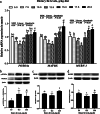Dietary isoleucine improved flesh quality, muscle antioxidant capacity, and muscle growth associated with AKT/TOR/S6K1 and AKT/FOXO3a signaling in hybrid bagrid catfish (Pelteobagrus vachelli♀ × Leiocassis longirostris♂)
- PMID: 33866964
- PMCID: PMC8054373
- DOI: 10.1186/s40104-021-00572-4
Dietary isoleucine improved flesh quality, muscle antioxidant capacity, and muscle growth associated with AKT/TOR/S6K1 and AKT/FOXO3a signaling in hybrid bagrid catfish (Pelteobagrus vachelli♀ × Leiocassis longirostris♂)
Abstract
Background: Muscle is the complex and heterogeneous tissue, which comprises the primary edible part of the trunk of fish and mammals. Previous studies have shown that dietary isoleucine (Ile) exerts beneficial effects on growth in aquatic animals. However, there were limited studies regarding the benefits of Ile on fish muscle and their effects on flesh quality and muscle growth. Thus, this study was conducted to explore whether dietary Ile had affected flesh quality and muscle growth in hybrid bagrid catfish (Pelteobagrus vachelli♀ × Leiocassis longirostris♂).
Methods: A total of 630 hybrid fish, with an initial average body weight of 33.11 ± 0.09 g, were randomly allotted into seven experimental groups with three replicates each, and respectively fed seven diets with 5.0, 7.5, 10.0, 12.5, 15.0, 17.5, and 20.0 g Ile/kg diets for 8 weeks.
Results: In the present study, we demonstrated that Ile significantly: (1) increased muscle protein and lipid contents and the frequency distribution of myofibers with ≤ 20 μm and ≥ 50 μm of diameter; (2) improved pH value, shear force, cathepsin B and L activities, hydroxyproline content, resilience, cohesiveness, and decreased cooking loss, lactate content, hardness, springiness, gumminess, and chewiness; (3) decreased reactive oxygen species (ROS), malondialdehyde (MDA), and protein carbonyl (PC) contents, GCLC and Keap1 mRNA levels, and up-regulated CuZnSOD, CAT, GPX1a, GST, and Nrf2 mRNA levels; (4) up-regulated the insulin-like growth factor 1, 2 (IGF-1, IGF-2), insulin-like growth factor 1 receptor (IGF-1R), proliferating cell nuclear antigen (PCNA), Myf5, Myod, Myog, Mrf4, and MyHC mRNA levels, and decreased MSTN mRNA level; (5) increased muscle protein deposition by activating AKT-TOR-S6K1 and AKT-FOXO3a signaling pathways.
Conclusion: These results revealed that dietary Ile improved flesh quality, which might be due to increasing nutritional content, physicochemical, texture parameters, and antioxidant ability; promoting muscle growth by affecting myocytes hyperplasia and hypertrophy, and muscle protein deposition associated with protein synthesis and degradation signaling pathways. Finally, the quadratic regression analysis of chewiness, ROS, and protein contents against dietary Ile levels suggested that the optimal dietary Ile levels for hybrid bagrid catfish was estimated to be 14.19, 12.36, and 12.78 g/kg diet, corresponding to 36.59, 31.87, and 32.96 g/kg dietary protein, respectively.
Keywords: Antioxidant capacity; Flesh quality; Hybrid bagrid catfish; Isoleucine; Myogenesis; Protein deposition.
Conflict of interest statement
The authors declare no conflict of interest.
Figures






Similar articles
-
Effects of dietary tryptophan on muscle growth, protein synthesis and antioxidant capacity in hybrid catfish Pelteobagrus vachelli♀ × Leiocassis longirostris♂.Br J Nutr. 2022 Jun 28;127(12):1761-1773. doi: 10.1017/S0007114521002828. Epub 2021 Jul 29. Br J Nutr. 2022. PMID: 34321122
-
Leucine Improved Growth Performance, Muscle Growth, and Muscle Protein Deposition Through AKT/TOR and AKT/FOXO3a Signaling Pathways in Hybrid Catfish Pelteobagrus vachelli × Leiocassis longirostris.Cells. 2020 Jan 30;9(2):327. doi: 10.3390/cells9020327. Cells. 2020. PMID: 32019276 Free PMC article.
-
Effect of dietary threonine on growth performance and muscle growth, protein synthesis and antioxidant-related signalling pathways of hybrid catfish Pelteobagrus vachelli♀ × Leiocassis longirostris♂.Br J Nutr. 2020 Jan 28;123(2):121-134. doi: 10.1017/S0007114519002599. Epub 2019 Dec 16. Br J Nutr. 2020. PMID: 31637992
-
Dietary tryptophan affects growth performance, digestive and absorptive enzyme activities, intestinal antioxidant capacity, and appetite and GH-IGF axis-related gene expression of hybrid catfish (Pelteobagrus vachelli♀ × Leiocassis longirostris♂).Fish Physiol Biochem. 2019 Oct;45(5):1627-1647. doi: 10.1007/s10695-019-00651-4. Epub 2019 Jun 3. Fish Physiol Biochem. 2019. PMID: 31161532
-
Effect of dietary isoleucine on skin mucus barrier and epithelial physical barrier functions of hybrid bagrid catfish Pelteobagrus vachelli × Leiocassis longirostris.Fish Physiol Biochem. 2020 Oct;46(5):1759-1774. doi: 10.1007/s10695-020-00826-4. Epub 2020 Jul 11. Fish Physiol Biochem. 2020. PMID: 32654084
Cited by
-
Dietary fishmeal replacement by Clostridium autoethanogenum protein meal influences the nutritional and sensory quality of turbot (Scophthalmus maximus) via the TOR/AAR/AMPK pathways.Anim Nutr. 2024 May 6;18:84-95. doi: 10.1016/j.aninu.2024.04.012. eCollection 2024 Sep. Anim Nutr. 2024. PMID: 39056058 Free PMC article.
-
An insight into role of amino acids as antioxidants via NRF2 activation.Amino Acids. 2024 Mar 20;56(1):23. doi: 10.1007/s00726-024-03384-8. Amino Acids. 2024. PMID: 38506925 Free PMC article. Review.
-
Dietary protein levels changed the hardness of muscle by acting on muscle fiber growth and the metabolism of collagen in sub-adult grass carp (Ctenopharyngodon idella).J Anim Sci Biotechnol. 2022 Aug 25;13(1):109. doi: 10.1186/s40104-022-00747-7. J Anim Sci Biotechnol. 2022. PMID: 36002862 Free PMC article.
-
Research Note: The influence of different isoleucine: lysine ratios on the growth performance of broiler chickens fed low-protein diets.Poult Sci. 2023 Jan;102(1):102270. doi: 10.1016/j.psj.2022.102270. Epub 2022 Nov 3. Poult Sci. 2023. PMID: 36435166 Free PMC article.
-
Effects of Restricted Feeding on Growth Performance, Intestinal Immunity, and Skeletal Muscle Development in New Zealand Rabbits.Animals (Basel). 2022 Jan 10;12(2):160. doi: 10.3390/ani12020160. Animals (Basel). 2022. PMID: 35049783 Free PMC article.
References
-
- Publishing Group in FAO's Office for Corporate Communication . FAO yearbook: Fishery and aquaculture statistics. 2020.
-
- Gisbert E, Mozanzadeh MT, Kotzamanis Y, Estévez A. Weaning wild flathead grey mullet (Mugil cephalus) fry with diets with different levels of fish meal substitution. Aquaculture. 2016;462:92–100. doi: 10.1016/j.aquaculture.2016.04.035. - DOI
Grants and funding
LinkOut - more resources
Full Text Sources
Other Literature Sources
Research Materials
Miscellaneous

